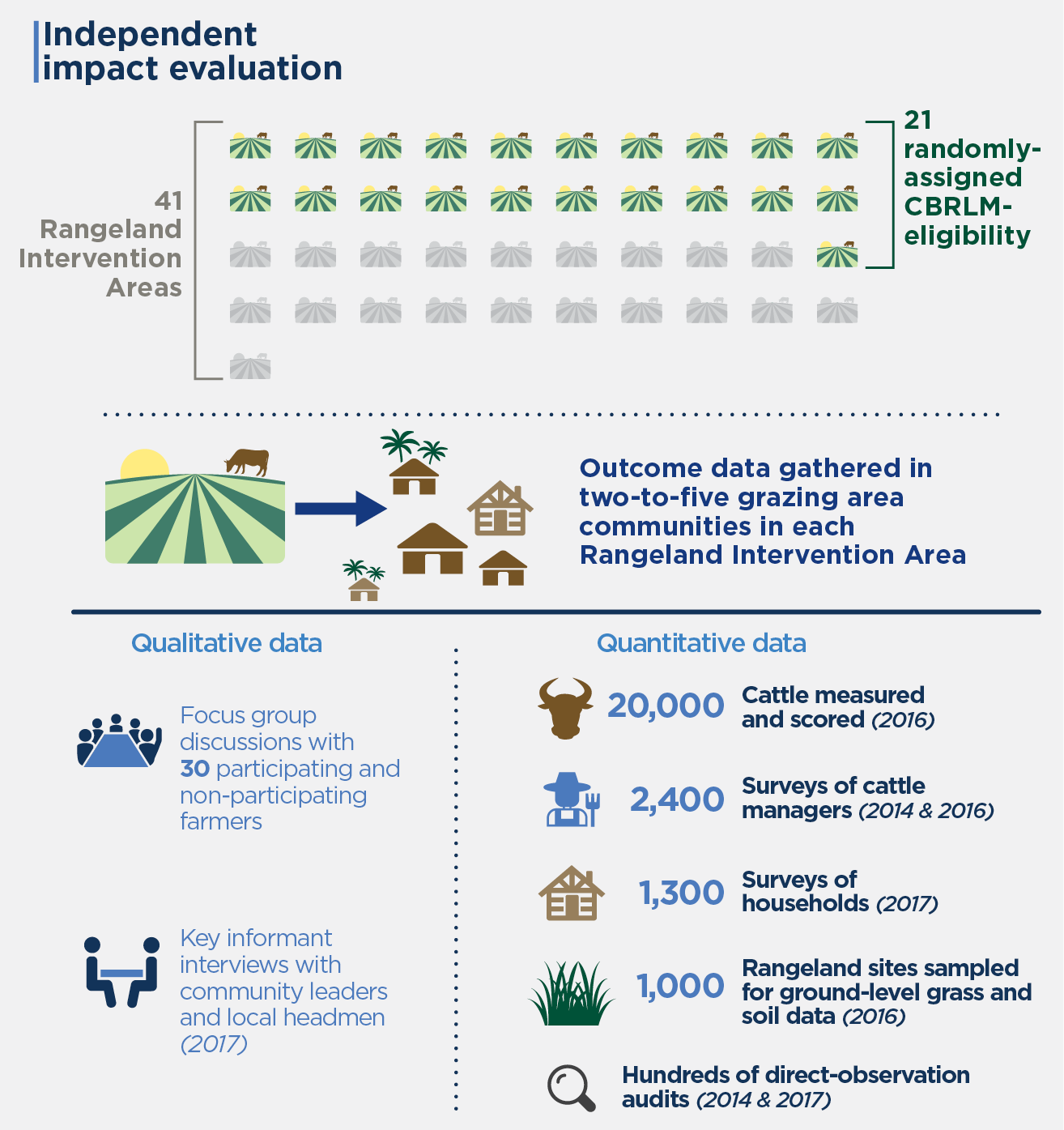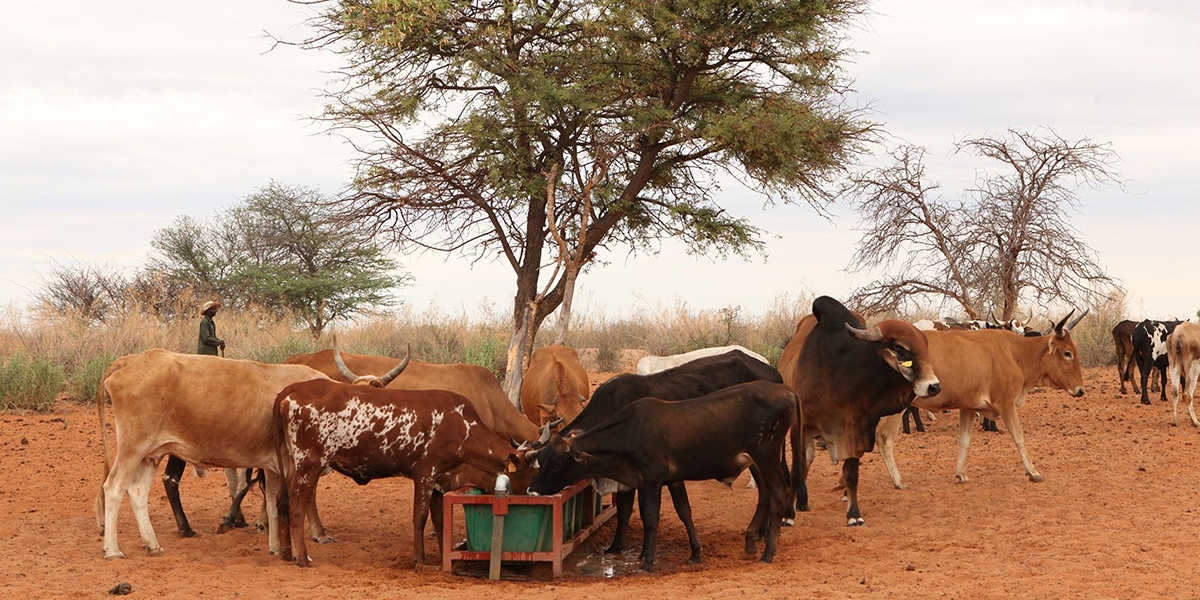Program Overview
MCC’s $304.5 million Namibia Compact ((2009–2014) supported rural development in Namibia’s Northern Communal Areas through the $12 million Community-Based Rangeland and Livestock Management Sub-Activity. The sub-activity was built on the theory that supporting land and livestock management strategies in communal areas would reduce rangeland degradation, improve livestock productivity, and ultimately raise farmer incomes.
Key Findings
Implementation and Uptake
- The program delivered trainings, support funds, livestock inputs, community facilitation, and water infrastructure as expected and met or exceeded three of seven output targets.
- Seventy-six percent of the herd managers in the 58 grazing area communities that enrolled in the program chose to participate.
Behavioral Outcomes
- Farmers in program areas were more likely than those in comparison areas to engage in collective rangeland management, including following a communal grazing plan, grazing their cattle in groups with their neighbors, and participating in grazing area committees.
- Farmers in program areas were also more likely to actively manage their cattle, including by deworming them and taking them to water sources more frequently.
- Program impacts on collective rangeland management persisted two years after the compact ended, but effects on animal husbandry practices diminished. The program did not impact livestock marketing or herd composition.
Rangeland, Livestock, and Economic Impacts
- Program areas exhibited slightly worse rangeland outcomes than comparison areas. No impact was detected on cattle herd size, health, or productivity, nor on household income, expenditure, economic security, or nutrition outcomes.
Evaluation Questions
This final impact evaluation answered several questions, including whether CBRLM:
- 1
Increased community governance and collective action? - 2
Improved rangeland management, livestock management, and livestock marketing practices? - 3
Increased rangeland sustainability, cattle herd productivity, and household income and well-being?
Detailed Findings
Implementation and Uptake
The CBRLM Sub-Activity was implemented widely: 58 grazing area communities actively participated, and the individual herd manager participation rate was 76 percent. In each participating grazing area, the implementer delivered an average of 1.2 water point installations or upgrades; 2.5 breeding bulls; $3,128 in matched funds for grazing area community group upkeep; water point maintenance; and 3–4 training sessions in rangeland management, bookkeeping, and leadership. The program fell somewhat short of contractual targets for the number of grazing areas achieving various levels of program adoption and the number of registered households. However, participating farmers expressed positive perceptions of CBRLM in focus group discussions and open-ended survey responses.
Behavioral Outcomes

The CBRLM program had a lasting, positive impact on behaviors related to rangeland management, collective action, and community governance. Farmers in CBRLM areas were 10 percentage points more likely than those in comparison areas to participate in grazing area committees, 13 percentage points more likely to use a written grazing plan, and 13 percentage points more likely to combine their herds together two years after the program concluded.
However, the extent of behavior change was limited: farmers did not increase livestock sales or restructure their herds as advised by the implementer, and improvements in herder support and animal husbandry best practices observed immediately after implementation were not sustained two years later. Data suggest that low prices (and low-quality cattle) and market frictions, such as transportation costs and distrust in buyers, were the primary barriers to larger changes.
Rangeland, Livestock, and Economic Impact

Despite a positive impact on community rangeland management practices, CBRLM had a statistically significant negative impact on 4 of 10 rangeland outcomes. The impact on the other six rangeland outcomes was negative but not statistically distinguishable from zero. There is some evidence that the decline in rangeland condition was the result of increased animal grazing, particularly by farmers from outside the grazing area. Rangeland sites in CBRLM areas were 12 and 13 percentage points more likely to be heavily grazed than sites in comparison areas during the rainy and dry seasons, respectively.
The evaluation found that CBRLM had no statistically significant effect on cattle weight or herd productivity, which is consistent with the lack of rangeland improvement. Predictably, without any improvements in livestock productivity or marketing, it follows that the evaluation found no statistically significant effect on household income, expenditure, economic security, nutrition, or livestock wealth. CBRLM cost an average of US$12,500 per participant.
Economic Rate of Return
MCC considers a 10 percent economic rate of return (ERR) as the threshold to proceed with an investment.
- 8.7%
Original ERR (2011) - -4.7%
Evaluation-Based ERR
The evaluator obtained this projection by updating MCC’s original model with parameters calculated for the evaluation. Although the costs and expected benefits for several complementary investments under the Namibia Agriculture Project were included in the original ERR (e.g., communal land tenure reform and marketing support), those interventions were ultimately implemented separately from CBRLM, so their costs and benefits were excluded from the updated CBRLM model.
CBRLM was expected to yield economic returns primarily through increased herd productivity and a higher rate of cattle sales. As described in the evaluation report, there is no evaluation evidence of the former and limited evidence of the latter. Notably, neither the original nor the updated ERR model incorporated the value of environmental changes or the cost to farmers of herding (e.g., opportunity cost and wages). Given the evaluation findings, including these factors would likely reduce the ERR further.
MCC Learning
Programs should have an evidence-based theory for the extent of behavior change necessary to achieve intended outcomes and be implemented in a way likely to foster that change.
Alignment between the costs imposed and benefits produced by program participation should not be ignored.
Where complex behavioral change is needed, or when it is unclear how to target or implement a program, learning should be built into the implementation approach.
Integrating complex programs and rigorous evaluation designs can be challenging but is particularly important to “get right” when implementing pilot programs.
Evaluation Methods

The independent impact evaluation of CBRLM used both quantitative and qualitative methods. The evaluation randomly assigned CBRLM eligibility to 21 of 41 Rangeland Intervention Areas and collected outcome data in two to five grazing area communities in each Rangeland Intervention Area that were considered most likely to participate based on pre-program indicators. The exposure period was between 3 and 6 years for behavioral outcomes and between 5 and 7 years for environmental, livestock, and economic outcomes.
The evaluation drew on a unique combination of data collection strategies to assess CBRLM’s impact across multiple dimensions. Qualitative data collection methods included focus group discussions and in-depth interviews to gauge changes in perceptions of the program and community governance. Quantitative data collection methods included surveying cattle managers in 2014 and 2016 to assess changes in management practices and social dynamics, corroborating self-reported behaviors with hundreds of direct-observation audits. Methods also included collecting ground-level grass and soil data to assess changes in ecological productivity and resilience; weighing, aging, scoring cattle to measure changes in cattle productivity and herd structure; and surveying households to assess impacts on income, expenditure, economic security, and nutrition.
2019-002-2251


